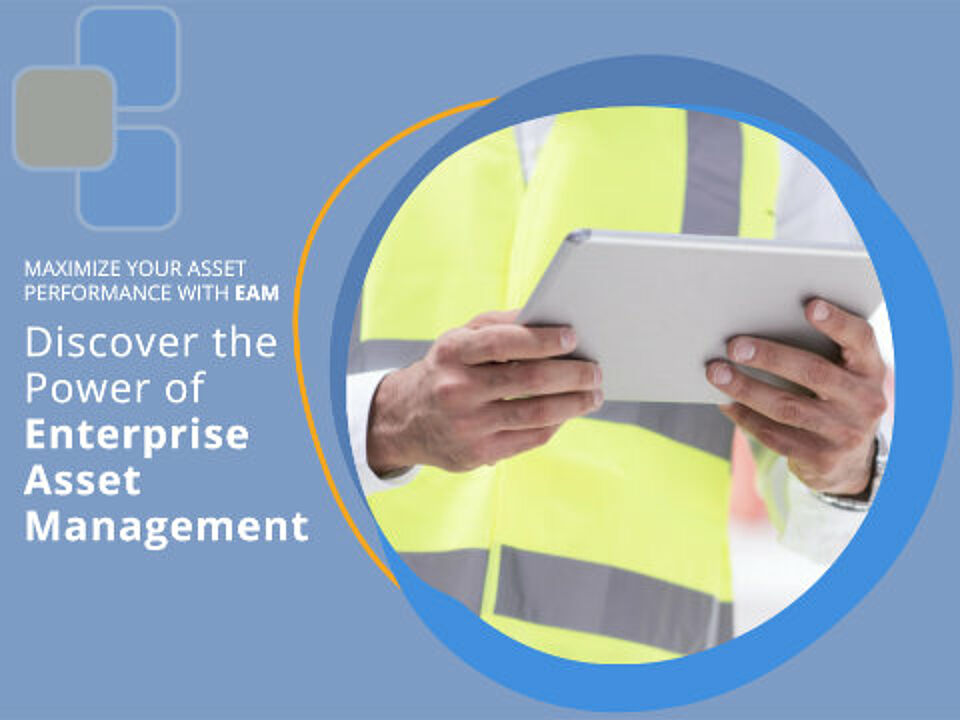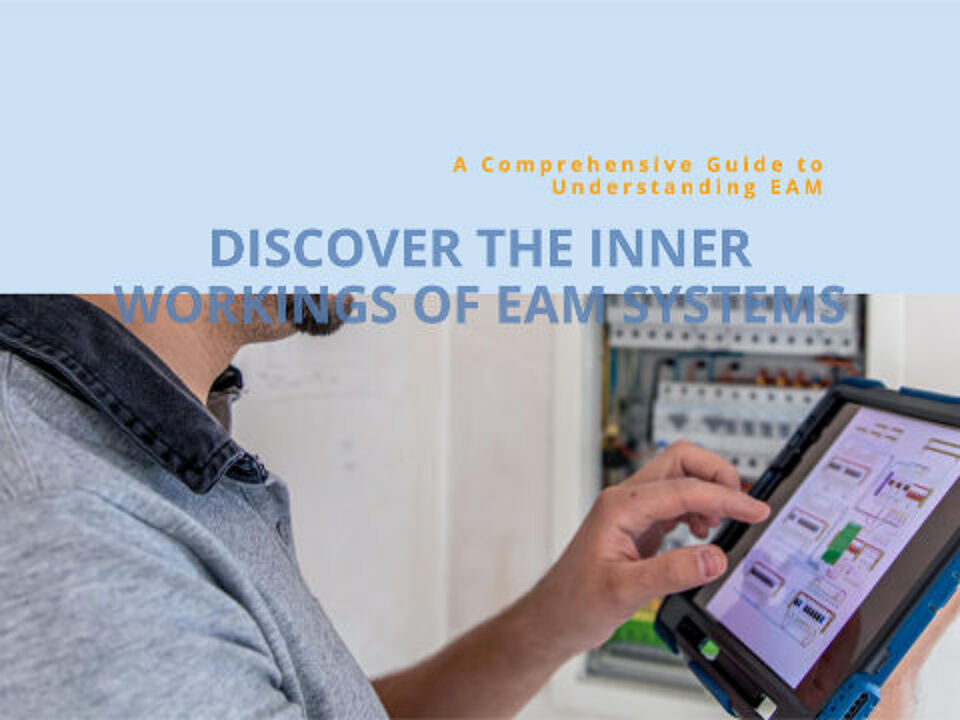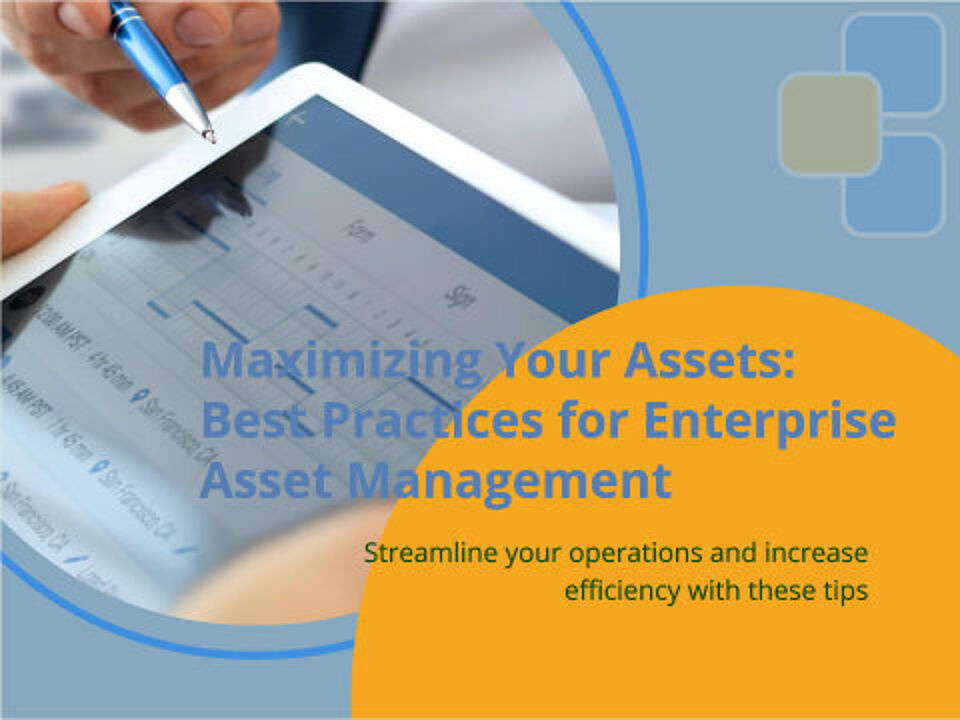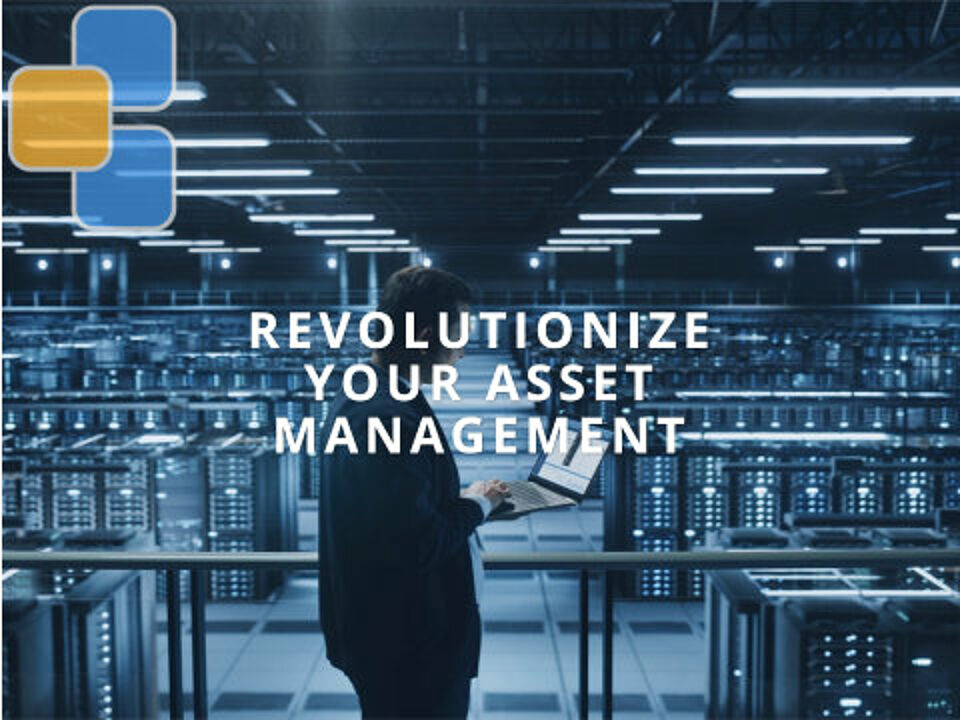Author: Jochen Möller (Managing Director and CoFounder of EcholoN) - creation: 07.09.2023, last change: 28.03.2024
Enterprise asset management refers to the holistic management and optimisation of facilities and assets in companies. It includes the planning, monitoring and maintenance of physical and non-physical assets throughout their lifecycle. By using EAM software, companies can increase their efficiency and make informed decisions regarding their assets.

What is Enterprise Asset Management?
Introduction to Enterprise Asset Management
Enterprise asset management is a concept that aims to optimise the life and performance of assets in organisations. This includes physical assets such as machinery and equipment as well as non-physical assets such as software licences and intellectual property. The main objective of EAM is to manage assets efficiently and increase their productivity throughout their lifecycle.
Benefits of Enterprise Asset Management
The benefits of enterprise asset management are many. Effective management and maintenance of assets can increase an organisation's efficiency and reduce costs. It also supports predictive analytics and EAM helps minimise downtime. It enables optimised decision making and improves asset performance.
The holistic approach of EAM
What sets EAM apart from other asset management systems is its holistic approach. EAM covers not only the management of physical assets, but also the integration of non-physical assets such as software licences and intellectual property. It also supports the automation and effectiveness of maintenance by monitoring work orders and optimising operational processes.

Why is Enterprise Asset Management important?
Increasing efficiency through EAM
Effective enterprise asset management can significantly increase the efficiency of a company. Operational processes can be improved through the optimised use and maintenance of assets. Work orders can be automated and monitored to ensure efficient execution.
Optimising productivity through EAM
EAM enables companies to optimise the productivity of their employees. By using assets efficiently and automating workflows, operational processes can be improved and bottlenecks minimised. This improves efficiency and increases productivity.
Reduce costs with EAM solutions
Through the targeted use of EAM solutions, companies can reduce their costs. Effective management and maintenance of assets leads to reduced downtime and repair costs. EAM systems also enable predictive maintenance, where potential problems can be identified and fixed early, before they lead to costly downtime.
Predictive analysis and reduction of downtime
One of the greatest benefits of EAM is the ability to perform predictive analysis. By continuously monitoring asset performance and using data from multiple sources, potential problems can be identified early. This allows companies to take proactive measures to minimise downtime and maximise the efficiency of their assets.

How do EAM systems work?
The management of assets throughout the life cycle
EAM systems enable the management of assets throughout their lifecycle. This includes planning and implementing preventive maintenance, recording assets and updating information in the system. By using EAM software, companies can monitor the condition of their assets and plan maintenance effectively.
Automation and effectiveness of maintenance
EAM systems offer automation features that improve maintenance effectiveness. Work orders can be automatically generated and routed to the right personnel for execution. Workflows can be optimised and response times minimised. This ensures that maintenance is carried out efficiently and in a timely manner.
Applications of EAM solutions
EAM solutions are used in various business areas. From production to facility management to IT service management, companies can benefit from EAM systems. Applications include asset management, service contract monitoring and asset performance analysis. By using EAM solutions, companies can optimise their operations and maximise their assets.
EAM software compared to CMMS
Enterprise Asset Management is often confused with Computerised Maintenance Management Systems (CMMS), as both systems deal with asset management and maintenance. However, the main difference is that EAM takes a holistic approach, while CMMS focuses on maintenance and repair. EAM also includes non-physical assets and supports decision-making at the enterprise level.

Best Practices for Enterprise Asset Management
Best practices for enterprise asset management include implementing a comprehensive asset management strategy, continuously updating and monitoring asset data, integrating EAM with other enterprise systems, using mobile solutions for on-site asset management, conducting regular asset assessments and using analytics tools to identify trends and areas for improvement. In addition, clear guidelines should be established for asset responsibilities and usage, and efficient maintenance management should be established to maximise the useful life of assets and minimise downtime.
Holistic asset management
Enterprise asset management describes the holistic management of assets in a company. In this process, all assets, such as machinery, equipment or buildings, are systematically recorded and managed. The aim of EAM is to ensure the efficient and cost-effective use of assets. Regular inspections, maintenance and procurement minimise downtimes and maximise the service life of the assets. Optimal resource planning and continuous improvement are fundamental to successful EAM.
Effective maintenance strategies
Effective maintenance strategies are critical to extending asset life and minimising unplanned downtime. A proven method to optimise maintenance processes is to implement an EAM software. With an EAM system, companies can better plan, manage and monitor their maintenance activities. By analysing data and using AI-based solutions, potential problems can be identified early and preventive measures can be taken. Effective maintenance strategies are an important part of efficient operations management and help to increase asset availability and save costs.
Use of EAM solutions in industries
In principle, all sectors of the economy that use relevant assets can benefit from asset. Examples can be given:
- In the manufacturing industry, companies usually have a large number of machines, equipment and plants.
- Energy and utilities companies such as utilities, grid operators, water treatment plants and other utilities have complex infrastructures that include power grids, pipelines and power generation facilities.
- Transport and logistics: Companies in the transport and logistics industry have a variety of vehicles, rail lines, aircraft and shipping facilities.
- Process industries such as chemical, pharmaceutical, food and beverage manufacturing and oil refineries have complex production facilities and systems that require efficient management. As the products in these industries are often not very diverse, good asset management can increase asset efficiency and thereby create a competitive advantage.
- Petroleum industry: The chemical, oil and gas industry includes complex facilities such as rigs, pipelines, refineries and storage facilities.
- Mining or construction industry: with its facilities and equipment (such as cranes and excavators), vehicles and systems.
- Healthcare: Hospitals and medical facilities have a variety of medical equipment and devices that require regular maintenance. EAM ensures equipment availability, improves patient safety and minimises costly downtime.
Integration of EAM with ERP systems
Integrating EAM with ERP systems is an important step in improving operational efficiency and productivity. EAM refers to the effective use of physical assets such as machinery, equipment and vehicles to achieve the maximum benefit for an organisation. On the other hand, ERP systems provide seamless integration of various business processes and functions such as financial management, human resources and purchasing. Integrating EAM with ERP systems enables smooth collaboration between the two areas. This leads to improved data integrity, efficient use of resources and better planning and tracking of assets. Access to real-time information also enables companies to react quickly to changes and optimise asset maintenance, repair and replacement.

How to choose the right EAM software?
Factors in the selection of EAM software
There are several factors to consider when choosing an EAM software. These include the requirements of the company, the scalability of the software, the ease of use and the integration with existing systems. It is important to conduct a comprehensive analysis of the requirements and compare the software with other EAM solutions to make the right choice.
Best practices for implementing EAM systems
Implementing EAM systems requires careful planning and execution. It is important to follow best practices to ensure a successful implementation. These include setting clear goals and milestones, training staff and regularly reviewing the performance of the systems. Close collaboration between different departments is also crucial.
EAM software in the cloud and the Internet of Things (IoT).
EAM software is increasingly being deployed in the cloud, making it easier to access and collaborate. By integrating IoT sensors, companies can collect and analyse real-time data from their assets to improve efficiency. Cloud-based EAM software and the IoT are opening up new opportunities for companies to make the most of their assets and make informed decisions.
EAM software in hybrid operation in the cloud and on premise
The hybrid operating model of EAM software offers companies the opportunity to run their applications both in the cloud and on premise. This allows for a flexible and customised solution that meets the specific needs of the company. With an On Premise solution, the EAM software is installed directly on the company's internal servers. As a result, the company retains full control over the resources and data used. In addition, specific adjustments and configurations can be made to optimally adapt the software to the company's processes. Another advantage of an on premise solution is the increased data security, as the company's own servers can be managed and protected internally. In comparison, a hybrid solution offers additional advantages. By integrating SaaS services, companies can benefit from the scalability, flexibility and cost savings that the cloud offers. In addition, the hybrid solution enables seamless integration between cloud and on premise components, enabling cross-company collaboration.
EAM - Frequently Asked Questions - FAQs
What is Enterprise Asset Management (EAM)?
Enterprise Asset Management, also known as EAM, is a system for managing corporate assets and facilities throughout their lifecycle. It encompasses the planning, maintenance, repair, analysis and optimisation of assets to increase efficiency and productivity.
What is the role of EAM in the industry?
EAM plays a critical role in industry as it is used to optimise and manage the operations of physical assets. It enables effective monitoring and automation of work orders to minimise downtime and increase productivity. EAM systems are used in various industries to manage the entire asset lifecycle and make informed decisions.
What is the difference between EAM and CMMS?
EAM and CMMS are two related terms in the field of asset management. EAM stands for Enterprise Asset Management, while CMMS stands for Computerised Maintenance Management System. While EAM covers the entire asset lifecycle and focuses on optimising and managing all enterprise assets, CMMS focuses specifically on planning and performing maintenance and repair work on assets.
What are the benefits of EAM?
Enterprise Asset Management helps companies effectively manage and optimise their assets. By using EAM systems, business processes can be automated, work order monitoring can be improved and operational decision making can be supported. EAM also enables predictive maintenance, reducing downtime and costs.
How does EAM differ from other management systems such as ERM or ERP?
Enterprise Asset Management (EAM) focuses specifically on managing physical assets, while Enterprise Resource Planning (ERP) aims to integrate and optimise all enterprise resources. EAM enables informed decision making on assets and their performance, while ERM looks at the entire supply chain and supply chain management.
What role does EAM play in increasing efficiency and productivity?
Enterprise Asset Management (EAM) helps increase productivity and efficiency by helping companies optimise their physical assets throughout their lifecycle. Implementing EAM solutions can automate work orders, simplify complex processes and improve asset performance.
What functions are included in Enterprise Asset Management?
Enterprise Asset Management includes functions such as asset registration, asset classification, maintenance planning, inspections, problem resolution, asset tracking, maintenance contract management, work order management, spare parts inventory and reporting.
What assets are covered in Enterprise Asset Management?
Enterprise asset management covers different types of assets, such as buildings, production facilities, vehicles, IT hardware, equipment and infrastructure. It can be used for both physical and virtual assets.
How is Enterprise Asset Management different from traditional maintenance?
Compared to traditional maintenance, which mainly focuses on troubleshooting, enterprise asset management involves a proactive approach that aims to predict potential problems and take preventive measures.

How does EcholoN support Enterprise Asset Management?
EcholoN is a holistic service management software with comprehensive EAM capabilities and standard process templates that helps companies efficiently manage their facilities and assets and optimise the entire asset lifecycle. With EcholoN, companies can better analyse their maintenance and servicing, increase efficiency and reduce downtime.
EcholoN as a comprehensive EAM system
EcholoN includes a comprehensive EAM system that helps companies effectively manage their assets. EAM integrates all the key functions of EAM, including monitoring, maintenance, repair, analysis and work order automation. EcholoN provides companies with a central platform on which they can manage all their assets. This includes physical assets such as plant, machinery and equipment as well as digital assets such as licences and databases, etc.
With EcholoN, companies can monitor the condition of their assets and detect potential failures at an early stage. The system offers various monitoring functions such as sensor integration, alerts and dashboards to ensure a comprehensive overview of the condition of the assets.
In addition, EcholoN supports companies in the planning and execution of maintenance and servicing activities. The system can automatically generate work orders, create maintenance plans and allocate resources such as personnel and materials. This helps companies to make their maintenance processes more efficient and minimise downtime.
EcholoN also offers extensive analytics that allow companies to identify trends and patterns in their asset data. This enables them to take preventive measures and develop long-term strategies to optimise their assets.
Another feature is the workflow engine. Among other things, it is used to automate work orders. The system can automatically forward work orders to the responsible employees and monitor progress. This allows companies to make their workflows more efficient and shorten response times.
Overall, EcholoN offers companies a comprehensive solution to effectively manage their assets. The system helps them monitor, maintain, service, analyse and automate work orders to maximise asset performance and minimise downtime.
EcholoN for effective asset management
With EcholoN, organisations can effectively manage their assets by capturing and tracking detailed information on asset condition, maintenance and repair history, and technical specifications. EcholoN provides an easy-to-use platform that allows companies to centrally store their asset data and access it at any time. By capturing and tracking information such as location, period of use and ownership, companies can keep track of their assets and make effective decisions.
The software also allows maintenance and repair schedules to be created and managed for each asset. By automatically reminding them when maintenance is due and tracking maintenance and repair histories, EcholoN can help companies maximise the condition and life of their assets and minimise downtime.
In addition, EcholoN provides a comprehensive overview of the technical specifications of each asset. Companies can record and track detailed information such as manufacturer, model number and warranty conditions. This allows them to ensure they have the right spare parts and technical documentation and use their assets effectively.
By effectively managing assets with EcholoN, companies can reduce costs, increase productivity and improve efficiency. Centralised collection and tracking of asset information enables companies to make better-informed decisions about optimising their asset usage and maintenance.
Overall, EcholoN provides a powerful platform for effective asset management that helps organisations use and manage their assets more efficiently while reducing costs.
EcholoN to automate work orders
The EcholoN Workflow Engine and process templates help organisations automate work orders. The Workflow Engine makes it possible to create complex workflows with different steps and activities. These workflows can then be used to create work orders and automatically distribute them to the responsible employees.
By automating work orders with EcholoN, companies can save time and resources. The process templates allow recurring workflows to be standardised and automated. This reduces errors and increases efficiency.
EcholoN also makes it possible to track the status of work orders in real time and inform employees about progress. This contributes to better transparency and communication within the company.
EcholoN also offers functions for monitoring and evaluating work orders. By collecting and evaluating data, companies can identify potential for improvement and continuously optimise their processes.
Overall, the automation of work orders with EcholoN enables an efficient and transparent organisation of work processes. Companies can optimally use their resources, minimise errors and increase productivity.
Perhaps also interesting:
- Blog - Article: Computerised Maintenance Management System (CMMS)
- Blog - Article: Maintenance, inspection, repair and overhaul
- Blog - Article: Field Service Management
- Blog - Article: Computer Aided Facility Management (CAFM)
- Blog - Article: Configuration Management, CMDB and Co
- Blog - Article: Service Asset Management
- Blog - Article: Internet of Things IoT
